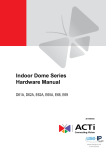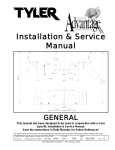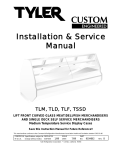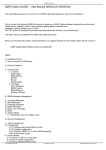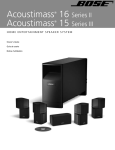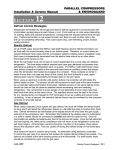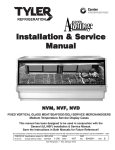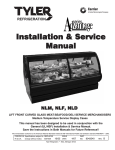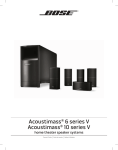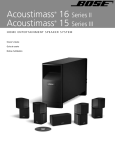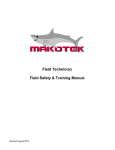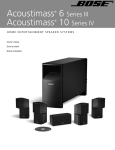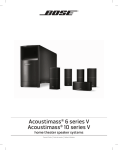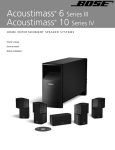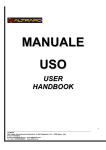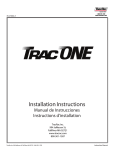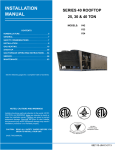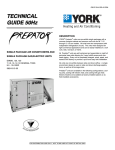Download Installation & Service Manual
Transcript
Installation & Service Manual GENERAL (UL/NSF) This manual has been designed to be used in conjunction with a Case Specific Installation & Service Manual. Save the Instructions in Both Manuals for Future Reference!! This merchandiser conforms to the UL Underwriter’s Laboratory, American National Standard Institute & NSF International Health and Sanitation standard ANSI/NSF 7 - 2003. TYLER merchandisers and/or components are patented. PRINTED IN Specifications subject to REPLACES IN U.S.A. change without notice. EDITION 10/04 ISSUE DATE 4/07 Tyler Refrigeration * Niles, Michigan 49120 PART NO. 9043544 REV. C.1 GENERAL (UL/NSF) CONTENTS Page Specifications Line Sizing Requirements . . . . . . . . . . . . . . . . . . . . . . . . . . . . . . . . . . . G-3 Gas Defrost Liquid Lines . . . . . . . . . . . . . . . . . . . . . . . . . . . . . . . . . . . . G-4 Pre-installation Responsibilites Shipping Inspections . . . . . . . . . . . . . . . . . . . . . . . . . . . . . . . . . . . . . . G-6 UL & ANSI/NSF Approval . . . . . . . . . . . . . . . . . . . . . . . . . . . . . . . . . . . . G-6 Pre-Installation Check List . . . . . . . . . . . . . . . . . . . . . . . . . . . . . . . . . . G-7 Installation Procedures Carpentry Procedures . . . . . . . . . . . . . . . . . . . . . . . . . . . . . . . . . . . . . . G-7 Case Line-Up . . . G-7 Trim Installation, Alignment and Case Sealing . . . . . . . . . . . . . . . . . . . G-10 Plumbing Procedures . . . . . . . . . . . . . . . . . . . . . . . . . . . . . . . . . . . . . . G-14 Recommended Drain Practices . . . . . . . . . . . . . . . . . . . . . . . . . . . . . . . G-14 Refrigeration Procedures . . . . . . . . . . . . . . . . . . . . . . . . . . . . . . . . . . . G-15 Refrigeration System . . . . . . . . . . . . . . . . . . . . . . . . . . . . . . . . . . . . . . . G-15 Control Options . . . . . . . . . . . . . . . . . . . . . . . . . . . . . . . . . . . . . . . . . . . G-16 Setting the Superheat . . . . . . . . . . . . . . . . . . . . . . . . . . . . . . . . . . . . . . . G-16 Temperature-Pressure Chart . . . . . . . . . . . . . . . . . . . . . . . . . . . . . . . . . G-17 Defrost Information . . . . . . . . . . . . . . . . . . . . . . . . . . . . . . . . . . . . . . . . G-19 Off Time Defrost . . . . . . . . . . . . . . . . . . . . . . . . . . . . . . . . . . . . . . . . . . G-19 Optional Electric Defrost . . . . . . . . . . . . . . . . . . . . . . . . . . . . . . . . . . . . . G-19 Optional Gas Defrost . . . . . . . . . . . . . . . . . . . . . . . . . . . . . . . . . . . . . . . G-20 Optional Air Defrost . . . . . . . . . . . . . . . . . . . . . . . . . . . . . . . . . . . . . . . . G-20 Installation Procedure Check Lists . . . . . . . . . . . . . . . . . . . . . . . . . . G-21 Use of Case Alignment Clamps . . . . . . . . . . . . . . . . . . . . . . . . . . . . . G-22 Cleaning and Sanitation General Cleaning Information . . . . . . . . . . . . . . . . . . . . . . . . . . . . . . . G-23 Case Cleaning . . . . . . . . . . . . . . . . . . . . . . . . . . . . . . . . . . . . . . . . . . . G-24 High Pressure Cleaning . . . . . . . . . . . . . . . . . . . . . . . . . . . . . . . . . . . . G-24 Cleaning Under Case with Base Rails . . . . . . . . . . . . . . . . . . . . . . . . G-25 General Information Proper Case Usage . . . . . . . . . . . . . . . . . . . . . . . . . . . . . . . . . . . . . . . G-25 Shelf Light Sockets . . . . . . . . . . . . . . . . . . . . . . . . . . . . . . . . . . . . . . . G-25 Shelving Loads . . . . . . . . . . . . . . . . . . . . . . . . . . . . . . . . . . . . . . . . . G-25 Service Instructions Preventive Maintenance . . . . . . . . . . . . . . . . . . . . . . . . . . . . . . . . . . . . G-26 800MA T-12 Lamp Replacement . . . . . . . . . . . . . . . . . . . . . . . . . . . . . G-26 T-8 Lamp Replacement . . . . . . . . . . . . . . . . . . . . . . . . . . . . . . . . . . . . . G-26 Remote Ballast Replacement . . . . . . . . . . . . . . . . . . . . . . . . . . . . . . . G-27 Fan Blade and Motor Replacement . . . . . . . . . . . . . . . . . . . . . . . . . . G-28 Color Band and Bumper Replacement . . . . . . . . . . . . . . . . . . . . . . . G-28 Raceway Cover Removal . . . . . . . . . . . . . . . . . . . . . . . . . . . . . . . . . . . G-30 Kickplate Removal . . . . . . . . . . . . . . . . . . . . . . . . . . . . . . . . . . . . . . . . G-30 Front Kickplate or End Close-off Removal . . . . . . . . . . . . . . . . . . . . G-31 TYLER Warranty . . . . . . . . . . . . . . . . . . . . . . . . . . . . . . . . . . . . . . . . . . . . . . . G-32 Revision Log Page G-2 . . . . . . . . . . . . . . . . . . . . . . . . . . . . . . . . . . . . . . . . . . .G-33 April, 2007 Installation & Service Manual GENERAL (UL/NSF) SPECIFICATIONS CAUTION Exposure to direct sunlight in over 80°F ambient temperatures can cause permanent damage to the vinyl materials. If exposure to direct sunlight is anticipated, loosely cover the cases with white canvas or plastic. This blocks direct sunlight and allows air movement over vinyl parts. TYLER will not be held responsible for damage due to improper storage. Line Sizing Requirements CAUTION Low temperature suction lines and all liquid lines must be insulated in all applications where subcooling (NC) is used! This prevents line damage and possible product damage caused by freezing. NOTE Liquid and suction line lengths over 300 equivalent feet are discouraged by TYLER. Contact applications engineering for recommendations on applications exceeding 300 equivalent feet! HORIZONTAL SUCTION LINES SHOULD SLOPE 1/2” PER 10’ TOWARD THE COMPRESSOR TO AID IN GOOD OIL RETURN! Suction Line Sizing The line sizing charts on each case specification sheet, shown above, can be used to size the sub-feed branch lines. When the line serves one case, select the size specified for the 6’, 8’ or 12’ case. This may be as small as 5/8” (example service meat cases), or as large as 1-3/8” (example multi-shelf ice cream cases). Select each suceeding step on the basis of the number of feet of case being October, 2004 ART 2 Revise line-up dimension art. served by that portion of the suction line. For more detailed Suction Line Sizing Charts, see “Suction & Liquid Line Sizing” (BUFF) section on the “TYLER Specification Guide”. Liquid Line Sizing Due to lack of space, the specification sheets have just one column for a liquid line size. The line sizes on the specification sheets are based on a 5 pound pressure drop for the entire piping run, from 50’ to 250’. Example: A 25,000 BTUH load will require a 3/8” line for 100 equivalent feet (Point A). At 150 equivalent feet, a 1/2” line would be required for the same load (Point B). For more specific line sizing information, see “Suction & Liquid Line Sizing”(BUFF) section in the “TYLER Specification Guide”. Page G-3 GENERAL (UL/NSF) Header along cases - 7/8” Line into cases are always 1/2” Note: Tees point down Main liquid line must be 5/8” minimum (even with just 1 case) Gas Defrost Liquid Lines 3’ Max. for gas defrost Gas defrost liquid lines to the cases should be branched off the bottom of the header. This ensures a full column of liquid to the expansion valve. A branch line from the header to an individual case should not be over 3’ long and must have a 3” expansion loop incorporated. -100°F to -40°F = 2.5” per 100 foot run (ultra low temp) Do not run suction or liquid lines through cases that are part of a separate system, especially if either has gas defrost. If there is no way to avoid this, insulate the piping for the portion that runs through the other cases. 30°F to 50°F = 1” per 100 foot run (high temp) Temperature variations of refrigeration and defrost cycles cause piping to expand and contract. Allowing for this expansion and contraction will prevent piping failures. The following are typical expansion rates for copper tubing; Page G-4 -40°F to 0°F = 2” per 100 foot run (low temp) 0°F to 30°F = 1.5” per 100 foot run (medium temp) Expansion loops are designed to provide a definite amount of travel. Placing the loop in the middle of a piping run will allow for maximum pipe expansion with the minimal amount of stress on the loop. Don’t use 45 degree elbows for loop construction because they will not allow the lines to flex. Refer to the charts on the next page for expansion loop lengths. Suction and liquid lines cannot be joined together or be allowed to touch. Pipe hangers must not restrict the expansion and contraction of piping. Insulation on suction and liquid lines makes the whole system more efficient! Insulate - it pays! April, 2007 Installation & Service Manual Expansion Loop Sizing Chart 1 is to be used for A, B, and C type expansion loops. Chart 2 gives the total length of the expansion joint (L) along the outer surface. Example: Given a 200’ run of 1 3/8” medium temp piping; there will be a linear expansion Type “A” Loop GENERAL (UL/NSF) of 3” to compensate for (medium temp 1.5” per 100’). Pipe diameter has no affect on the amount of linear expansion but is needed for determining the size of the expansion loop. Find the 3” column at the top of Chart 1 and go down until it crosses the 1 3/8” row. The X dimension is 24”, 48”, or 72” for A, B, or C type expansion loop respectively. Type “C” Loop Type “B” Loop Tube O.D. ‘X’ Length - (in inches) for Linear Expansion of: Tube O.D. ‘L’ Developed Length of Expansion Offsets October, 2004 Page G-5 GENERAL (UL/NSF) PRE-INSTALLATION RESPONSIBILITIES Shipping Inspections Shipping Damage stated. Refer to “Liquid and Suction Line Sizing Information” section in this manual for TYLER’s requirements. All equipment should be thoroughly examined for shipping damage before and during unloading. This equipment has been carefully inspected at our factory and the carrier has assumed responsibility for the safe arrival of our product. If damage is concealed or apparent, a claim must be made to the carrier. Apparent Loss or Damage Obvious loss or damage must be noted immediately on the freight bill or express receipt and signed by the carrier’s agent. If this is not done, the carrier may refuse the claim. The carrier will supply the necessary claim forms. Concealed Loss or Damage When the loss or damage is not apparent until after the equipment has been uncrated, a claim for concealed damage must be filed. Upon discovering the damage, make request in writing to the carrier for inspection within 15 days and retain all packing. The carrier will supply the inspection report and required claim forms. Application Recommendations These cases are designed and built to be used in properly air conditioned stores that maintain a store temperature at or below 75F (dry bulb) and a 55% relative humidity. These cases may not operate satisfactorily at higher temperature and humidity conditions. Temperature performance is important for controlling bacteria growth. The installer is responsible for following these instructions as set forth within this Installation and Service Manual. Any variance will produce poor performance, thus releasing TYLER Refrigeration from any liability. Refrigeration piping must be sized as described within this manual by the installer. Normal applications require refrigeration piping to be insulated unless otherwise Page G-6 One of these labels will be displayed on each product, or as part of the bottom portion of the namelplate label. NOTE: The NSF label began with service case production. TYLER Refrigeration of Niles, Michigan meets UL and NSF International certification requirements. NSF certification is accredited by American National Standards Institute (ANSI) and the Standards Council of Canada (SCC). Manufactured products are built to meet UL requirements which includethe ANSI/NSF 7 standards for Commercial Refrigerators and Storage Freezers. These standards provide basic criteria to promote sanitation and protection of public health in the manufacturing, operation and cleanability of TYLER cases. All cases will be grouped in one of these categories; TYPE I display refrigerators where ambient temperatures are typically maintained at 75°F of less. Storage and display intended for packaged products only. TYPE II display refrigerators for ambient temperatures typically maintained at 80°F or less. Display refrigerators intended for storage and display of NONHAZARDOUS FOODS consisting of unprocessed produce and packaged products only. The information contained herein is based on technical data and tests which we believe to be reliable and is intended for use by persons having technical skill, at their own discretion and risk. Since conditions of use are outside TYLER’s control, we can assume no liability for results obtained or damages incurred through the applications of the data presented. SPECIFICATIONS ARE SUBJECT TO CHANGE WITHOUT NOTICE. Printed in the U.S.A. September, 2007 Installation & Service Manual Pre-Installation Check List WARNING These cases are very heavy and require two or more people to unload, move, position and/or install them. Improper handling of these cases could result in personal injury. NOTE Cases with legs are shipped to stores on castors installed on the base frame. If floor transition from the truck to the delivery dock is smooth, cases may be rolled directly to the sales floor area. If not, castors should be removed in the truck and cases should be unloaded and moved by one of the conventional methods. All cases containing glass MUST be stored and installed on level surfaces to avoid possible product damage and/or glass breakage. 1. Check for hidden damage while unloading and unpacking of the case. 2. Check the “shipped loose” parts for any items; such as legs, shelves, nuts and bolts, caulking, access doors, etc. GENERAL (UL/NSF) INSTALLATION PROCEDURES Carpentry Procedures Case Line-Up Before starting the case line-up, review the store layout floorplans and survey the areas where case line-ups are going to be installed. WARNING • These cases are very heavy and require two or more people to move, position and/or install them. • Do not walk on the tops of these cases. Tops of cases are not designed to support the weight of a human being. Improper handling of these cases could result in personal injury. NOTE Allow at least 3” of air space between the back of these cases and store walls or other cases to minimize possible condensation problems. Forced ventilation might be necessary in some situations. 3. Check the equipment - remove the screws used to hold down the deck pans during shipping. Remove the pans and check the following, if applicable: 4. Remove all packing material. 5. Check all flare nut connections for tightness. 6. Check all fan bracket bolts for tightness. 7. Check all electrical plug-in connections for positive seal. 8. Make sure the expansion valve feeler bulb is securely attached to the suction line. 9. All field wiring and plumbing MUST conform to national, state, and local codes. 10. Do not remove plugs (from flare nuts) or caps (from threaded connections) until the unit is ready for final hook-up. All coils are pressurized and have a Schrader Valve access fitting. If pressure has been lost, check for leaks. October, 2004 1. Snap chalk lines where the front and rear legs and/or base rails of the cases are to be located for the entire line-up. Page G-7 GENERAL (UL/NSF) NOTE Front and rear edges of legs and/or base rails should always be used to line-up cases. Cases with legs have built-in leveling adjustment capabilities. Cases with base rails use 6” shims that allow adjoining ends of cases to be shimmed together. 2. Cases with legs are shipped on pallets with the legs in an attached shipping package. Position case approximately where it is going to be installed. Carefully lift case off skid, with a proper lifting device, and install legs into the threaded holes in the base. Make sure all legs are completely threaded into the base to properly secure them. Thread out bottom leg insert, up to 1 1/2”, to level the case. If case has base rails, locate highest point on chalk lines as a reference for determining the number of shims to be placed under the case base rails. Position first case at highest point on the chalk lines and shim case supports as required. CAULKING 3. Apply two heavy beads of caulking compound from the Filler Kit to the end of case at dotted (. . .) and dashed (- - -) lines. Proper caulking provides good case refrigeration and sanitation. Check leveling at hand rails, top of case, and back of case. CAUTION Shipping braces should only be removed from case ends that are to be joined. This protects the cases from possible damage during the line-up procedure. NOTE A foam gasket is factory installed on one end of the case. This gasket fits into a groove on the adjoining case when cases are pulled together. Do not depend on the foam gasket alone to make a good seal! Page G-8 4. On multi-shelf cases, remove bottom tray (1), front duct (2) and rear and/or top pull-up access covers (3). October, 2007 Installation & Service Manual On single deck cases, remove bottom tray (1), front duct (2) and rear pull-up access cover (3). GENERAL (UL/NSF) On NNG, N3MG, N2P(S) cases, remove bottom tray (1), front cladding (4), and/or rear pull-up access cover (3). On cases with legs, pull-ups are accessible under and behind the case corners. 5. The remaining backers and hardware are in a plastic bag taped to the interior of the case. 6. Push cases tightly together making sure the pull-ups are aligned. On waterfall produce cases, remove bottom tray (1) and access covers (3). On island cases, remove front and rear pull-up access covers (3). October, 2004 Page G-9 GENERAL (UL/NSF) 7. Adjust legs (not shown) or add shims (5), as required, under the adjoining case base rails (6). Check leveling at hand rails (7), top of case (8), and back of case (9). NOTE: Shelving bracket slots must be aligned. Use recommended case alignment clamps to help installation. See page G-22. CAUTION Do not drill or use other holes through the case end for pull-ups. This may deform the case end and could cause joint leaks and/or poor refrigeration. 8. Position all pull-up bolts and/or mounting hardware (10) at pull-up locations (A and B), (A, B and C) or (A, B, C, and D). Do not tighten any pull-up hardware until all of it has been installed. Tighten all pull-up hardware equally starting at point A and finishing at point D. Do not overtighten. Page G-10 9. Install all pull-up access covers (3), front duct (2), bottom tray (1) and/or front cladding (4), where applicable. 10. Remove shipping tape from all fluorescent lamps. Trim Installation/Alignment Upper Trim Installation Loosen screws as needed to line-up the canopy hoods. Hoods are adjustable in all directions. 1. Position canopy joint trim (1) over any gap between the canopy hood joint (2). Secure canopy joint trim (1) with screws at top and bottom as shown. 2. Install top pull-up access cover (3) to cases (4) with four screws (5). April, 2007 Installation & Service Manual Horizontal Joint Trim Installation GENERAL (UL/NSF) NOTE Make sure top of front glass is aligned be- fore installing the front glass trim. 1. Apply bead of caulking compound from the Filler Kit to the top of each horizontal joint (1). If gap at horizontal joint is too large, pull together with sheet metal screws (2) or pop-rivets (3). NOTE If additional sealing is preferred, 2” wide duct tape can be applied to the top of the internal bottom joint between cases. The tape will be covered by the horizontal joint trim. Duct tape is not furnished. 1. Position front glass trim (1) over the top and in front of the glass joint (2). 2. Using holes in front glass trim (1) as a guide, drill holes in front glass retainer (3). 3. Secure front glass trim (1) with two screws (4). Bumper and Color Band Adjustment 1. Slide hand rail/bumper retainer (1) and bumper (2) towards the center of the lineup to butt them against the adjoining hand rail/bumper retainer (1) and bumper (2). 2. Apply sealer to horizontal joint trim (4) and install joint trim (4) on the horizontal joint (1). Front Glass Trim Installation The following instructions can be used to install the front glass trim on cases with 6” or 12” front glass. October, 2004 2. Position hand rail backer (3) to cover any remaining space between the adjoining hand rail/bumper retainers (1). NOTE Color band backers on glass front cases are installed by sliding the band toward open end, inserting the backer at the case joint and sliding the band back over the backer. Installation of backer at last joint in a line-up requires bumper and bumper retainer removal on the end case. Page G-11 GENERAL (UL/NSF) Raceway Cover Installation NOTE Raceway covers are shipped loose. They should not be installed until all case piping and electrical hook-ups are complete. 3. To adjust a bumper backer (4): remove bottom of both bumpers (2) at the joint; reposition the bumper backer (4) behind the joint; snap bumpers (2) back in place. Make sure color band backer is centered behind any exposed color band joints. 1. Position top of raceway cover (1) in bottom of lower cladding (2). 2. Center the raceway backer (3) behind joint of adjoining raceway covers (1). 3. Rotate raceway cover (1) down and position retainer plates (4) with screws (5). Slide all raceway covers (1) toward center of case line-up then tighten retainer plate screws (5). 4. After all bumpers (2) in a case line-up have been pushed together towards the center, snap on and position bumper end trim (6) so it covers any end gap between the end of the bumper and the patch end. 4. After raceway covers have been slid together towards center of case line-up and secured, install top of raceway end trim (6) in lower cladding (2) and secure bottom with screw (7). Page G-12 April, 2007 Installation & Service Manual GENERAL (UL/NSF) Kickplate and End Closeoff Installation (High & Low Base Models without Legs) NOTE • Seal the front base rail to the floor before installing kickplate supports. • Kickplate supports MUST be installed before piping case. • Kickplate and end closeoff should not be installed until all case piping and electrical hook-ups are complete. 3. Install metal kickplate (4) onto kickplate supports (1 or 2) and secure with screws. 4. Install kickplate joint trim (6) over each metal kickplate joint in the lineup and secure with screws. 1. Using Dow-Corning 732, 737, 999A or equivalent NSF silicone adhesive (not supplied), completely seal bottom front edge of front baserail to floor. This includes any gaps made from the shims used for leveling the case lineup. Correctly applied silicone must fill the gap between the base rail and the floor and completely contact both the front base rail and the floor. 5. Install the lower end closeoff (7) between bottom of patch end and case base rail and secure with screws. The flanged end of the closeoff (7) should cover the end of the metal kickplate (4). 6. Seal bottom edge of lower end closeoff (7) to floor using Dow-Corning 732, 737, 999A or equivalent NSF silicone adhesive (not supplied). NOTE Sealing base rails and end closeoffs will keep floor spills from running under case lineups. 2. Position slots of kickplate support assemblies (1) or kickplate support (2) over premounted base rail shoulder screws (3). Push kickplate supports (1 or 2) down until they are flush with the floor. October, 2004 Page G-13 GENERAL (UL/NSF) Front, Rear and End Closeoff Installation (High Base Models with Legs) NOTE Closeoffs should not be installed until all case piping and electrical hook-ups are complete. Both the front and rear closeoff assemblies install the same way. Plumbing Procedures Recommended Drain Practices CAUTION A clogged waste outlet blocks refrigeration. This could result in inadequate case cooling and possible food spoilage. The installer is responsible for the proper and code approved installation of a system which dispenses condensate waste water through an air gap into the building’s indirect waste system. Waste outlets and drip pipes from refrigerators are not intended for direct connection to the building plumbing system. All remote refrigerators equipped with automatic or off time defrost systems are provided with a waste outlet. The outlet is located in the lowest level of the compartment to which waste water will drain. 1. Position front or rear closeoff assembly (1 or 2) so bottom edge is flush with the floor. Push in closeoff assembly (1 or 2) at each case leg locations until the closeoff brackets (3) snaps onto each leg (4). All TYLER display refrigerators are provided with a water seal. It may be factory installed or shipped loose for field installation. If shipped loose, the installer must follow TYLER’s installation procedure as outlined within this manual. The importance of proper drain connections cannot be overemphasizes. Complications resulting from drainage problems can be avoided by following these good drainage guidelines. 2. Install the end closeoff (5) between bottom of patch end and case frame. The flanged end of the end closeoff (5) should cover both the ends of the front and rear closeoff assemblies (1 & 2). Page G-14 1. The minimum slope of waste pipe should be 1/4” per foot, or more if possible. April, 2007 Installation & Service Manual 2. The maximum length of waste pipe should not exceed 12 feet. 3. Never downsize the drain lines. Lines should be at least the same diameter as the trap. GENERAL (UL/NSF) Refrigeration Procedures Refrigeration System CAUTION • Protect Schrader valve core and cap and the expansion valve feeler bulb from excessive heat by removing them when necessary. Replace properly before starting the system. • Brazing and welding operations should be kept away from both the drain pan and sealing materials in the drain area. High temperature exposure in these areas may cause damage to seals and/or painted surfaces of the drain pans. 4. On low temp cases, the trap must be away from the tee to prevent possible freezing of the trap. The type of refrigerant used in the case will be specified on the unit nameplate. A Schrader valve is provided at the left of each coil for system testing and charging. The suction and liquid lines to the evaporator coils are capped off. This holds the dry nitrogen charge inside the evaporator coils. When cutting off the caps, use a tubing cutter to prevent the introduction of copper shavings to the system. See the model specification sheet in the case specific I&S manual for proper line entry and positioning specifications. 5. Up to two case drains can utilize one floor drain. NOTE: Both case drains require individual water seals. Only use clean, dry, sealed refrigeration grade copper tubing. Make copper to copper joints with phos-copper alloy (5% silver) or equal. Make dissimilar metal joints with solder having 35% silver. To prevent internal contamination of the line, limit the use of soldering paste or flux to the minimum required. Flux only the male portion of the connection. Piping should be purged with dry nitrogen or carbon dioxide during brazing. This prevents the formation of copper dioxide and scale during brazing. Copper dioxide and/or scale can easily clog the small ports in system valves and pilot valve. 6. Never put two case drains with two traps on the same waste pipe. This can cause an air trap on one of the case drains. October, 2004 Page G-15 GENERAL (UL/NSF) NOTE The tubing design pressure is 183 psig for the lowside and 390 psig for the highside. Do not exceed these pressures. Line Entry Refrigeration lines entry may only require a single entry for an entire line-up of cases. It could enter the line-up at one end or branch both ways from the center. Refrigeration lines may be run from case to case in areas designated for them. Notches are provided in both ends for this purpose. Line sizing should meet the suction and liquid sizing requirements for that case location in the line-up. See “Line Sizing” section in this manual. If the cases are connected to a parallel system, the line size will be specified on the system printout. CAUTION Do not run tubing through these cases to another machine if the cases are controlled by a pressure control. Pressure sensed from the coldest location could affect the pressure control in a second system. This is called cross-controlling and should be avoided. A pressure drop in the suction line means a loss in system capacity. It forces the compressor to operate at a lower suction to maintain the desired temperature in the evaporator coil. Pressure drops reduce compressor capacity and increase system compression ratios causing higher operating costs. To minimize pressure drop, keep the refrigeration line run as short as possible and the number of fittings to a minimum. All suction lines should be insulated to minimize heat absorption and condensation drippage. Seal refrigeration lines where they enter the case. Sealing is necessary to prevent condensation, air leaks and other problems. Be sure it is done before leaving the job. Page G-16 NOTE It is very important to have a good seal around the refrigeration lines. This will prevent any water leakage into the bottom of the case. During the installation process do not disturb the factory seal between the drain and case ends. This seal must remain water tight. The access opening should be insulated along with all refrigeration lines exiting the case to prevent condensation buildup on cold surfaces. Control Options The temperature of case line-ups can be controlled by one of the following methods:* 1. Indoor single compressor system not using a liquid pump down before defrost. The low pressure control on the compressor system can be set to cycle the compressor on and off at specific pressures that correspond to the desired temperature range at the case. 2. Indoor single compressor system needing a more accurate temperature control. A thermostat can be mounted with its sensing bulb in the discharge air stream on the case. The thermostat is used to cycle the compressor on and off at specific temperature to maintain the desired case temperature range. 3. Outdoor single compressor system using a liquid pump down cycle before defrost, or other applications that need a more accurate temperature control. A thermostat can be mounted with its sensing bulb in the discharge air stream on the case. The thermostat is used to cycle a main liquid line solenoid valve on and off at specific temperatures to maintain the desired case temperature range. The liquid line solenoid valve used for temperature control should be mounted as close to the case as possible to minimize the temperature swing that may occur after the valve closes. April, 2007 Installation & Service Manual 4. Parallel compressor system, or other applications needing a more accurate temperature control. An evaporator pressure regulator (EPR) valve is installed between the case and the compressor. The EPR valve is set to control the case suction pressure which corresponds to the desired case temperature. The EPR valve will hold a relative constant pressure at the case and will not allow it to go below a set pressure. *See model specification sheet in the case specific I&S manual for specific control settings for each case. Setting the Superheat Use the instructions, illustration, and chart below to determine the superheat. NOTE: This illustration shows the general location of piping and components in a case with two expansion valves. 1. Make sure all connections to the expansion valve(s) are tight. 2. If a case has more than one expansion valve, starve the flow to the front coil’s expansion valve by turning in the adjusting screw 1 1/2 turns. NOTE: Rear coil expansion valve should always be adjusted first. 3. Install pressure gauge on the coil output. Most TYLER cases have a Schrader fitting for this purpose. Record the pressure reading. March, 2006 GENERAL (UL/NSF) 4. Using the table on the following page, convert this pressure to a temperature. 5. Take a temperature reading from the suction line adjacent to the expansion valve bulb being tested. 6. Subtract the temperature conversion (step 4) from the suction line temperature (step 5). This is the superheat of the evaporator. 7. If case has more than one expansion valve, reset front coil expansion valve by repeating steps 2 thru 5. See next page for adjustment settings for Sporlan and Alco Expansion Valves. Balanced Port Expansion Valves used in TYLER cases are preset by an air pressure bench test. Some final adjustment may be necessary due to system designs, pressure drops, and coil loading. Adjustments should be made with liquid pressures near design, and after the case has been loaded and pulled down to normal temperature requirements. Final adjustments are used to maximize case temperature and efficiency. There is no magic superheat number. Proper settings can actually occur from as low as 4 or 5°F up to extremes of 17 or 18°F of superheat. Most settings will fall in the 6 to 12°F range. All high performance case settings should fall in the 4 to 6°F range. A proper method is to find a setting within the ranges previously mentioned that provides the most stable bulb temperature. Sometimes there will be a flat reading with virtually no variation. This usually provides the lowest discharge air temperature reading. Proper expansion valve settings cannot be made in a few minutes. Only turns of 1/4 to 1/2 should be made at one time. Wait 15 minutes to allow the system to settle out. Please refer to comments below regarding the differences in adjustment between Sporlan and Alco expansion valves. Page G-17 GENERAL (UL/NSF) CAUTION Forcing the adjustment beyond the stops will result in damage to the valve. NOTE All of the following changes are approximate and should only be used as a guideline! TEMPERATURE-PRESSURE CHART SPORLAN VALVES: The number of adjustment turns available between stops on the Sporlan valves is 9 to 10 turns (in or out). • With R-22 refrigerant, 1 turn will result in approximately a 5.5 or 3°F superheat change for low or medium temperature applications respectively. • With R404A refrigerant, 1 turn will result in approximately a 4.5 or 2.5°F superheat change for low or medium temperature applications respectively. • With R-502 refrigerant, 1 turn will result in approximately a 5 or 2.5°F superheat change for low or medium temperature applications respectively. • With R-507 refrigerant, 1 turn will result in approximately a 4.5 or 2.5°F superheat change for low or medium temperature applications respectively. Page G-18 ALCO VALVES: The number of adjustment turns available between stops on the Alco valves is 10 to 12 turns (in or out). • With R-22 refrigerant, 1 turn will result in approximately a 4.5 or 2°F superheat change for low or medium temperature applications respectively. • With R404A refrigerant, 1 turn will result in approximately a 3.5 or 1.5°F superheat change for low or medium temperature applications respectively. • With R-502 refrigerant, 1 turn will result in approximately a 3.5 or 1.5°F superheat change for low or medium temperature applications respectively. • With R-507 refrigerant, 1 turn will result in approximately a 3.5 or 1.5°F superheat change for low or medium temperature applications respectively. April, 2007 Installation & Service Manual Defrost Information NOTE See Case Specific I&S manual for individual defrost settings and klixon locations. Off Time Defrost All cases that use a refrigerated coil that operates below the freezing point of water will collect frost during the refrigeration cycle. Too much frost build-up on the cooling coil stops the effective air flow and refrigeration. An off time control stops the refrigerant and allows the case to defrost at the proper time and duration each day. The refrigeration is stopped with a time clock (mechanical or electronic) by either turning off the compressor directly, or closing a liquid line solenoid or suction isolation valve (ex. suction line solenoid or suction stop EPR valve). The time clock is set for the proper number of defrosts per day and the proper duration per October, 2004 GENERAL (UL/NSF) defrost based on the information provided under “Specifications” in the case specific manual. The time clock may be an individual clock on single compressor system; a multi-circuit clock on parallel compressor system; or an electronic clock on either compressor system. Optional Electric Defrost When an electric defrost is initiated, power is supplied to the defrost heater. The defrost heater is located in front of the coil. The defrost heater will be turned off or deenergized when the defrost limit klixon clipped to the right end of the coil, opens at its specified temperature. Balanced 3-Phase Defrost Wiring The largest number from any of the following will be the highest load on any single phase. This is called the high leg amps. In the following example a TG-3-30 defrost module is required. Page G-19 GENERAL (UL/NSF) L1 = All Loads on leg 1 x 1.73 2 activate and deactivate the drain pan heater as needed during the defrost cycle. L2 = All loads on leg 2 x 1.73 2 L3 = All loads on leg 3 x 1.73 2 13.8 13.8 8.6 8.6 Optional Air Defrost EXAMPLE: L1 = 13.8 + 8.6 + 8.6 x 1.73 = 26.8 amps 2 L2 = 13.8 + 13.8 x 1.73 2 = 23.9 amps L3 = 13.8 + 8.6 + 8.6 x 1.73 = 26.8 amps 2 In this case the high leg amps equals 26.8. Optional Gas Defrost When a gas defrost is initiated, the evaporator acts as a heat exchanger for incoming liquid during the refrigeration cycle and as a drain pan heater during gas defrosting. A defrost termination klixon is located at the bypass check valve. When the defrost termination klixon senses the appropriate temperature, it shuts off the flow of hot gas. Most cases use a 55° or 60°F defrost termination klixon that will represent 70°F due to time lag. Use 70°F termination setting for electronic temperature sensors. On N6D deli cases, meat cases and glass door cases , the fans are deactivated during gas defrost by a fan delay klixon located on the right end of the coil. Fan operation will restart when the klixon senses the appropriate temperature. On glass door cases, there is an additional klixon used to Page G-20 Most TYLER multi-shelf meat and deli merchandisers can be equipped with air defrost. Air defrost effectively defrosts with comparable product quality to electric or gas defrost, but costs less. The reversible permanent split capacitor (PSC) fan motors which make air defrost possible, cuts the cost of fan operation considerably. The motor design and the capacitor required for reversal makes the motor much more efficient. When an air defrost is initiated, fan operation is reversed. This causes the fans to circulate store air in place of refrigerated air supply. A klixon (42°/32°) is located on the right end of the coil. When all cases on that circuit have reached 42°F, the defrost will be terminated and the fans will switch back. The purpose of the following arrangements is to stop the flow of refrigerant through the display so that it may defrost: Single Condensing Unit Liquid flow may be interrupted by a normally closed liquid line solenoid valve (installed at the compressor or case) controlled by a thermostat and wired to the time clock. The time clock would cause the solenoid to close, this would in turn shut off the flow of liquid refrigerant to the system(s). The compressor April, 2007 Installation & Service Manual would continue to run and pump down the system(s). The condensing unit would soon shut off on low pressure. The time clock may also be wired directly to the compressor contactor. Parallel Compressor Unit For cases operated from a parallel compressor rack, an evaporator pressure regulator (EPR) valve may be factory installed on the suction stub of the parallel compressor rack. The EPR valve will work in conjunction with the defrost circuit(s). This is temperature regulation (by pressure) of the entire lineup. A solenoid may be used in conjunction with the EPR valve to stop refrigerant flow during defrost. Installation Procedure Check Lists Carpentry (Line-Up) Check List 1. Make sure there is a smooth transition from the truck to the delivery dock before rolling cases with casters off the truck. NOTE All necessary hardware and caulking can be found in the Filler Kit located in the well of each case. 2. Check the level of the floor area where the cases are going to be lined up. 3. Set and level the first case at the highest point on the floor. NOTE Adjacent cases may require different amounts of levelling or shimming to allow for proper case line-up. 4. Level cases as necessary (legs with leveling inserts or shims) to align case pull-ups, fronts, tops, and allow for proper operation. 5. Have case to case joints been properly caulked and sealed? Each joint requires two beads of caulking where the cases join together. One bead on the inside and outside of the foam gasket and door frame assures good sanitation and refrigeration. See “Case Line-Up” in this October, 2004 GENERAL (UL/NSF) manual for proper caulking locations. 6. Have the patch ends been properly caulked and installed with the proper hardware? 7. For cases with shelves, make sure the shelving bracket slots on multi-shelf cases line-up and that the shelves are installed in the proper position. NOTE The bumpers should all be pushed tight against the center case in the line-up before the end trims are installed. 8. After cases are completely installed and where local sanitation codes mandate, seal front bottom edge of front base rails with Dow-Corning 732, 737, 999A or equivalent NSF silicone adhesive (not supplied). 9. Make sure all bumpers, front cladding, raceway covers and kickplates or front and rear closeoffs are properly installed and secured. Install end trims and seal bottom edge (if required) with NSF silicone adhesive (not supplied). Plumbing Check List 1. All plumbing must conform to all national, state and local codes. NOTE Be sure the drain is installed in accordance with the following specifications and the drain instructions in this manual. 2. The minimum slope should be 1/4” per foot or more if possible. 3. The maximum length should not exceed 12 feet. 4. Never downsize the drain lines. Lines should be at least the same diameter as the trap. CAUTION Hooking two cases and traps into the same drain line will cause an air trap in one of the two cases. This will cause improper drainage to the case with the air trap. 5. Two cases can utilize one floor drain as long as both lines and traps are run separately to that drian. Page G-21 GENERAL (UL/NSF) Electrical Check List 1. All field wiring must conform to national, state and local codes. 2. Make sure all electrical connections are properly connected and tight. Refrigeration Check List In addition to the standard practices which should be used in the installation of this case, the installer should pay particular attention to the following items: 1. Has the refrigerant line entry been caulked thoroughly? 2. Are all fans running? Are the fan electrical connections tight? NOTE Proper settings and/or temperatures for items 3, 4 and 5 can be found in the “Model Specification Sheets” in the case specific I&S manual or the “BUFF” section in the Specification Guide. temperature. Check for outside influences that might affect the case performance. (Example: Drafts from ventilator openings or radiant heat from light fixtures that are too close.) Use of Case Alignment Clamps 1. Check and mark the floor where the cases are to be set. 2. Set the first case in the line-up on the highest point of the floor. 3. Level the first case end-to-end and front-toback using the legs or provided shims. NOTE On cases with base rails, 6” shims should be placed beyond the end of the base rails so the next case can be set on the same shims. NOTE Individual case alignment clamps are available through TYLER Service Parts Department under Part No. 5092494. 3. Is the defrost control set for correct number of defrosts per day? 4. Is the failsafe set for the proper times? 5. Does the discharge air temperature match the recommended temperature for this case? 6. Is the suction pressure drop less than 2 PSIG from the last case to the compressor? (Remote case only) 7. Are the expansion valve feeler bulbs securely attached to the suction lines? 8. After final hook-up of the case, let it run through a defrost cycle (preferably two or more). Check the duration and frequency of the defrost cycle for compliance to specification data. 9. Check the operating temperature to be sure the case is functioning within the recommended guidelines. 10. Verify that the store temperature and humidity levels are within the recommended guidelines. Use a wet and dry bulb psychrometer to check the store Page G-22 4. Set the next case in the line-up. Use two alignment clamps on the horizontal joint in the bottom of the cases. The clamp near the front of the cases will line-up the hand rails. The clamp near the back of the cases will line-up the shelving bracket slots. 5. Level the case end-to-end and front-to-back, by adjusting legs or shimming base rails. 6. Adjust the alignment clamps as needed to allow for the installation of pull-up hardware. NOTE Do not remove alignment clamps until the pull-up hardware has been tightened. April, 2007 Installation & Service Manual CLEANING AND SANITATION General Cleaning Information Equipment life and performance are directly related to good cleaning and sanitation practices. Recommended cleaning intervals will vary depending on the case’s useage. Cleaning cases, case parts and area around cases regularly will keep high sanitation levels, increase case life, and minimize maintenance costs. Most TYLER cases provide the following case cleaning features to support good cleaning and sanitation practices. GENERAL (UL/NSF) • Do not use liquid chlorine bleach or products containing bleach on metal surfaces. The corrosiveness of these products will damage the metal and void the case warranty. Metal surfaces that are powder coated should be cleaned daily with a damp cloth. After initial installation, apply coat of appliance wax to these surfaces. Repeat wax application as necessary to keep surfaces shining. Stainless steel surfaces should be cleaned as needed with a damp soft cloth. In addition, stainless steel cleaners may be used to help protect surfaces longer. • Removable screens, lower trays and front & rear ducts. • Fully accessible 1-1/2” or 2” waste outlets on most cases. • Hinged or easily removable fan panels and coil & piping covers provide access to lower coil and drain pan. • Seamless, smooth drain pan is water-proof and contoured for easy cleaning and rapid drainage. • Cases with pipe legs have removable front and rear closeoffs to provide access to area under cases for easy cleaning. • Cases with base rails provide front or side access for cleaning areas under cases with dust mop or vacuum hose with nozzle. (See page G-13 in this manual for resealing of lower end close-offs.) Since cases are made up of different types of materials, the care requirements change with the material type and style. Rigid vinyl surfaces (bumpers, handrails & raceway covers) should be cleaned with a soft cloth and warm soapy water, or with non-abrasive cleaners like Fantastik or Pro Formula 409 with a mildly abrasive sponge. Both of these cleaners will do an excellent job in most instances. Clean difficult spots with Comet cleanser with chlorinal and a plastic scrubber or abrasive sponge. Manufacturers directions should be followed carefully. CAUTION Do not use hot water on cold glass surfaces. This can cause the glass to shatter and could result in personal injury. Allow glass fronts, ends and service doors to warm before applying hot water. • Never use abrasive scouring pads or cleansers on exterior or interior surfaces. The abrasive materials could scratch the surfaces. • Do not use any ammonia based cleaning products on any cases with electronic and solid state components. The ammonia will permanently damage these components. April, 2007 CAUTION Do not use Comet on corner or vacuum formed trim. Discoloration could occur. Corner trim for island cases and vacuum formed trim for wedge cases should be cleaned only with Fantastik or Pro Formula 409. Cleaned surfaces treated with Armour All or Pledge furniture polish will help keep surfaces looking good and make them easier to clean. WARNING Exterior and interior glass surfaces, brushed aluminum and chrome should be cleaned with a lint-free cloth and warm water or glass cleaner. Page G-23 GENERAL (UL/NSF) Remove normal accumulation of dirt and debri daily to maintain efficient refrigeration. Interior surfaces require different cleaning intervals. Cases should be cleaned and sanitized per Federal, State and Local Ordinances. Typically, meat and produce cases should be cleaned at least once a week; dairy cases every two to four weeks; and frozen food cases every two to six months. Interior surfaces may be cleaned with most domestic detergents and sanitizing solutions with no harm to the surfaces. Honeycombs or grids in the air ducts should be checked and cleaned whenever the case interior is cleaned. To clean a honeycomb or grid, loosen the screws and slide retainer back, or remove screws and retainer to remove honeycomb or grid from the air ducts. Clean the honeycomb or grid with copressed air, vacuuming system, or spray detergent and rinse. Make sure the honeycomb or grid is dry before replacing it in the case. Reinstall honeycomb or grid in air duct and secure with retainer and screws. Case Cleaning All case cleaning is dependent on proper installation of the cases with good caulking between cases and adequate case drainage system. Cleanout holes in bottom trays facilitate case drainage. NOTE Consult a service agency for proper method of shutting off the refrigeration and electrical supply. 1. Shut off refrigeration supply to the case(s) and electrical power to the case fans, anti-sweat wires and internal lights. 2. Remove product from case and store in an another case or walk-in facility. 3. Remove screens, trays, bottom pans, ducts (where applicable) and all removeable interior covers. Clean parts separately as discribed on this page. CAUTION Do not soak lighted shelves! Water will short or damage the shelf lighting system. 4. If case has lighted shelves, remove and clean separately by wiping with a damp Page G-24 cloth. Make sure receptacle covers are installed when shelves are removed. 5. Remove all loose debris from the case. It could clog the drain during cleaning. NOTE • If a germicidal detergent is not available, rinse after cleaning and apply a sanitizer. Sanitizer should thoroughly drain and air dry. • When cleaning and rinsing this case, try not to use water faster then the case drain can carry it away. 6. Clean surface with warm water and germicidal detergent at recommended concentration. A brush or cleaner pad will aid in removing dirt. Don’t soak electrical wiring and fans unnecessarily. Rinse thoroughly with clean water and let air dry. 7. Sanitize the case with Quaternary Ammonium Solutions (ex: KAYQUAT II, J-512 Sanitizer, SANIQUAT 512, etc...) approved per 21CFR 178.1010, followed by adequate draining and air drying. These solutions may be obtained from Kay Chemical Co., Johnson Wax Professiona,l Coastwide Laboratories, etc.... 8. Replace all internal parts so that they seat properly. This is necessary for proper case operation. WARNING Never turn case electrical power on until all components are dry! Reconnecting power to case with wet components could cause damage the case or personal injury. 9. Restart refrigeration supply to the case(s) and electrical power to the case electrical circuits. 10. Replace product after the case has reached the proper operating temperature. High Pressure Cleaning If a high pressure cleaner is used for case cleaning, the following cleaning precautions must be taken to discreetly flush the case. WARNING Wear safety goggles while using high pressure equipment. This equipment is designed to operate at 500 psi pressure. High pressure water and/or flying objects April, 2007 Installation & Service Manual could cause eye or other bodily injuries. • Remove all loose and removable electrical components before using high pressure equipment. • Do not use water over 160°F. Water too hot will cook soil into place and obscure the worker’s visability. • Do not misuse high pressure spray equipment by directing spray on any electrical equipment such as fan motors and light sockets. • Do not direct high pressure spray at case joints or glass joints. The seals may not hold up to the high pressure. GENERAL INFORMATION Proper Case Usage Display Practices Do not let a flair for spectacular exceed the refrigerating capacity of the cases. Mounds of product over the load lines or large signage cards interfere with case air flow. Displays of products in multi-shelf cases require rotation to prevent frost accumulation. Jumble displays of cans should be avoided. Uneven display surfaces cause extra air turbulence that make heavier frost deposits on the coils. Stocking & Maintenance Practices for Multi-Shelf Low Temperature Cases A large volume of air is constantly in motion in all makes of multi-shelf low temperature cases. When the case is defrosted, air temperature rises for the short time it takes the case to defrost. The relatively warm air causes frost to be deposited on the cold products. Most frost is removed naturally, shortly after the defrost cycle ends. However, some frost may remain on the products stored in the back of the case. Product rotation is the moving of product from the rear to the front and adding new stock to the rear. This prevents frost from accumulation on products stored in the rear of the case. NOTE Frozen foods are perishable and cannot be left on display indefinitely. October, 2007 GENERAL (UL/NSF) Clean multi-shelf cases regularly. Removing loose bits of wrappers or other debris daily, prevents the need for shutting down the case for major cleaning. Keeping drain clogging litter out of the case is very important in preventing refrigeration failure or sub-par performance. Shelf Light Sockets Both types of shelf light plug sockets allow for shelf positioning. One shelf light socket is vertically adjustable. It moves up or down to clear back edge of shelf for electrical connection. Remove top screw stop to completely remove this shelf light socket assembly. The second shelf light socket is stationary, but allows the plug to be installed right side up or upside down to accommeodate the shelf position. Remove top and bottom retainer pins to remove the second shelf light socket assembly. CAUTION Make sure the shelf light plugs or receptacle covers are completely inserted into the light socket receptacles. This prevents electrical arcing and/or possible equipment damage . Shelving Loads Case shelves are designed to hold approx. 40 lbs per sq. ft. NOTE: Slots in the shelf brackets engage in the back of the shelves when the brackets are in a down position. This provides additional shelf support. Shelf Load Chart Shelf Size (in) 12 x 48 15 X 48 18 X 48 20 X 48 22 X 48 Shelf Area (Sq. Ft.) 4 5 6 6.7 7.3 Maximum Shelf Load 160 200 240 268 292 Page G-25 GENERAL (UL/NSF) SERVICE INSTRUCTIONS Preventive Maintenance 1. Set up a routine cleaning program, as outlined in this manual. Make sure employees are aware of the need for proper case cleaning and follow the recommended guidelines. WARNING Always shut off electricity to case before cleaning and/or inspecting electrical components and/or connections. Moisture on electrical components could cause electrical shock and/or personal injury. 2. When cleaning this case, don’t overlook such things as the fan blades and coils. Be sure to keep fan blades and exposed coils free of dirt and dust. Accumulated dirt on fan blades could lead to premature fan motor failure. 3. Make it a policy to perform routine inspections of the electrical connections. Check them for loose connections and/or frayed wires. Make sure the lamp guards are installed correctly. Serious problems can be avoided by taking care of small problems when they are found. windows, or doors can adversely affect the case performance. Extra lighting can also affect the case temperature. WARNING Fluorescent lamps contain mercury. Do not put lamps in trash. Recycle or dispose the mercury as a hazardous waste. T-8 Lamp Replacement (Canopy or Shelf) WARNING Shut off light switch or disconnect power supply before changing a lamp. 600V lighting system and/or ballast surges can burn out adjacent lamps and/or cause personal injury or death. NOTE Unplugging a shelf lamp will shut off all the shelf lamps in that case section. Installing the receptacle cover in place of the lamp plug will complete the circuit and turn on the rest of the shelf lamps in that case section. 4. Keep the drains clean and free of debris. Clogged drains rob the case of needed refrigeration. 5. Do not use ammonia or ammonia based cleaners on or around electronic or solid-state components. The ammonia will damage these components. 6. Periodically inspect the insulation around the suction lines. Repair or replace any loose or missing insulation. These lines must be insulated at all times. 7. Make sure the case is loaded correctly. Do not use large signage in a case. Do not let the product block or cover the air ducts, or extend above the “load lines”. Keep the product stored or stacked neatly. 8. Check the enviroment around the case. Misdirected air drafts from fans, open Page G-26 1. Pull down both end caps (1) to separate them from lampholders (2). 2. Pull end caps (1) from ends of lamp (3) and/or lampshield (4). Remove lamp (3) from lampshield (4). 3. Insert new lamp (3) in the lampshield (4), where applicable. Install end caps (1) on ends of lamp (3) and/or fully seat in ends of lampshield (4). 4. Push up both end caps (1) into lampholders (2) until they snap into place. 5. Turn on the light switch or reinstall shelf lamp plug. April, 2007 Installation & Service Manual Remote Ballast Replacement WARNING Shut off or disconnect power supply to case before changing a ballast. 600V electrical power from wire ends could damage other components and/or cause personal injury or death. GENERAL (UL/NSF) CAUTION Make sure all wiring is tucked out of the way to prevent pinching and/or wire damage during light fixture installation. 6. Secure canopy light channel (1) in top of case. 7. Reconnect or turn on the power supply to the case. Fan Blade and Motor Replacement WARNING Shut off or disconnect power supply to case before servicing a fan. Automatic cycling of fan or electrical power to wire ends could cause personal injury and/or death. 1. Disconnect and/or loosen canopy light channel (1) until it hangs down enough to provide access to the light ballasts (2). NOTE Mark wires before removing to assure proper installation. Fan Blade Replacement 1. Remove bottom tray(s) (1) from case (2). 2. Disconnect wires (3) to defective ballast (2). 2. To replace fan blade (3), remove spring clip (4) and fan blade (3) from fan motor shaft (5). Discard spring clip. 3. Remove mounting screws and defective ballast (2) from light channel (1) or mounting bracket (4). 3. Install new fan blade (3) on fan motor shaft (5) and secure with new spring clip (4). 4. Install new ballast (2) on light channel (1) or in mounting bracket (4) and secure with mounting screws. 4. Replace bottom tray(s) (1) in case (2). 5. Connect wires (3) to new ballast (2) in same position as they were removed. October, 2004 Page G-27 GENERAL (UL/NSF) Fan Motor Replacement 1. Remove bottom tray(s) (1) from case (2). 2. Remove three screws and mounting brackets (7) from fan plenum (8). 3. Carefully lift fan motor assembly and unplug wire connector. 4. Remove three screws, bracket mounting plate (6) and mounting brackets (7) from fan motor (5). Color Band and Bumper Replacement The bumper, hand rail/bumper retainer and color band attach together to form a single assembly. To replace any part of this assembly, follow these procedures. Color Band Replacement NOTE If replacement blades and/or motor are not available, unplug motor and cover opening until the replacement parts are available. 5. Replace new fan motor assembly in reverse order. 1. Starting at one end, carefully pry top end of color band (1) from top of the hand rail/bumper retainer (2). 2. Work top of color band (1) free from the full length of hand rail/bumper retainer (2). 3. Lift color band (1) off top of bumper (3). Do not lose or misplace the color band backer (4) from behind the color band (1) joint area. 4. Position color band backer (4) behind joint area between color bands (1) and install new color band (1) in reverse order. NOTE Color bands on glass front cases can only be removed by first removing the bumper and bumper retainer. These color bands DO NOT snap out as is the method with non-glass front cases! To replace the band, simply slip the band out of the glass retainer, replace and re-install band, bumper retainer and bumper. Page G-28 April, 2007 Installation & Service Manual Bumper Replacement NOTE Make sure color band has been removed before replacing the bumper. GENERAL (UL/NSF) Hand Rail/Bumper Retainer Replacement NOTE Make sure the color band and bumper have been removed before replacing the hand rail/bumper retainer. 1. Push in on center of bumper (1) while pulling out on bottom of bumper (1). This will start to separate bumper (1) from hand rail/bumper retainer (2). 2. Make sure the bottom of the bumper (1) is released from the hand rail/bumper retainer (2) for the full length of the case. 3. After bottom is released, firmly pull out top of bumper (1) to snap it free from hand rail/bumper retainer (2). 4. Remove bumper backers (3) from both ends of bumper (1). 5. Install new bumper (1) in reverse order. 1. Mark position of the hand rail/bumper retainer (1) on front of case (2). 2. Position hand rail backers (3) into ends of hand rail/bumper retainers (1) not being replaced. 3. Remove mounting screws (4) and hand rail/bumper retainer (1) from front of case (2). NOTE Hand rail/bumper retainer must be installed in same position as removed to assure proper fit and alignment during installation. 4. Install new hand rail/bumper retainer (1) on front of case (2) with mounting screws (4). 5. Position hand rail backers (3) to cover any remaining space between adjoining hand rail/bumper retainers (1). 6. Install the color band (4) in the bumper (1) and bumper retainer (2). October, 2004 6. Replace the bumper (5), color band (6) and end trim (7) (where applicable) on the hand rail/bumper retainer (1). Page G-29 GENERAL (UL/NSF) Raceway Cover Removal On some straight front cases, raceway covers need to be removed to provide electrical access. 1. Remove screws (1) and raceway cover retainers (2) from bottom section of raceway cover (3) that is being removed. Kickplate Removal (Cases with Base Rails) 1. If removing kickplate from the end of a case lineup, remove three screws and slide out lower end close-off (1) from between bottom of patch end and case base rail. 2. Remove mounting screws and kickplate joint trim(s) (2) from kickplate (3) section being removed. 3. Remove mounting screws and kickplate (3) from kickplate support (4 or 5). 4. Replace kickplate, kickplate joint trim and lower end close-off in reverse order. 2. After all raceway cover retainers have been removed, rotate raceway cover (3) up and pull down to remove it from the lower cladding (4). NOTE: Additional holding pressure may be required at case joint to keep backer intact. 5. Using Dow-Corning 732, 737, 999A or equivalent NSF silicone adhesive, reseal bottom edge of lower end close-offs to floor (if required by local sanitation codes). On high base cases, most meat and produce cases, raceway access is gained by removing the lower front cladding. Remove the screws from the top of the lower cladding and slip out the bottom tabs from the slots in the base supports. Be sure to replace all screws when re-installing the cladding! Page G-30 April, 2007 Installation & Service Manual GENERAL (UL/NSF) Front Kickplate or End Close-off Removal (Cases with Legs) 1. Remove screws (1) and slide kickplate joint trim (2) to one side. 3. To remove a front kickplate or rear lower close-off (8), grasp end of front kickplate or rear lower close-off (8) and pull out until leg support clamps (9) release from the case legs (5). 4. Replace front kickplate or lower close-offs in reverse order. 2. If removing a front kickplate section from the end of a case lineup, remove end close-off panel (3) by pulling it out to release the leg support clamps (4) from the case legs (5) and down to clear the adjustable top panel (6) from behind the patch end (7). October, 2004 Page G-31 (Equipment Warranty updated in October 2008) Page G-32 April, 2007 Revision Log This log sheet is intended to track both major and minor revisions to this manual, and to describe what the nature of the revision is. Revision identification is located in the lower right corner of the cover page. Major revisions are lettered alphabetically, dated accordingly, and require reprinting for inclusion with the product at shipment. Minor revisions are denoted after the major revision with a “period” followed by a sequential number, and do not require a printed update. All manuals with any revision changes will be available in electronic PDF format on the Tyler Refrigeration website. Content changes that determine the type of revisions are decided on a case-by-case basis by Tyler internal management. This revision log was created in December of 2008. REVISION TYPE DATE Dec 2008 MAJOR MINOR C.1 DESCRIPTION NSF document inspection ... Updated Warranty Page ... RESULTS ... minor change in text copy as needed. ... minor addition in warranty content. Page G-33


































